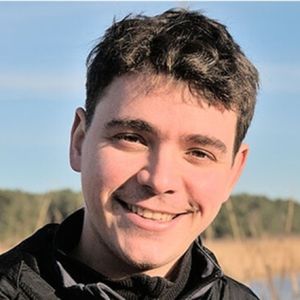In the best case scenario, I don't have to hear anything
Alexander Drexler records biodiversity via audio. Bioacoustic monitoring is the technical term for it. For the PaludiZentrale project, he uses it to record biodiversity on areas before and after rewetting, in particular before and after cultivation in paludiculture.

What does bioacoustic monitoring actually look like? Looking out for dragonflies and then holding the microphone close to them? No, in bioacoustic monitoring we record the vocalisations of species with permanently installed microphones. The sounds are of animal origin. We evaluate these recordings and draw conclusions about the species present.
It's pretty clear with birds, but insects? Which species can you record? It's true, I can record a lot, but the question is how well it can be analysed. Bird song is usually unambiguous and can be analysed well using artificial intelligence (AI). This also works for some insects such as grasshoppers. But for bees, for example, I am not yet aware of any analyses. We also record bats. The difficulty here: We can't hear their ultrasonic sounds with our ears. There are special devices for this, but identifying individual species from their calls is not easy. It is at the limit of what our devices can do, but it is feasible. It is also conceivable, for example, to record amphibians, possibly even insects under water. Scientists from Manchester are trying this.
What is the advantage of bioacoustic monitoring? The method is not tied to a specific time or person. The interference with nature is minimal and enables comparable results from recordings in different areas. We do not scare up any animals and do not remove them. For comparison: when mapping birds, people could never map for as long as our devices record. For bats, netting would be the alternative. In contrast bioacoustic monitoring is passive and we only have to intervene minimally in nature.
How did you come across this method? I came across it during my studies with Prof Dr Frank Dzoizck at the Dresden University of Applied Sciences. I also have a slight affinity for technology and have built audio recorders for the university and other organisations, for example for projects or planning offices.
This easily adds up to hundreds of hours of audio recordings - it's difficult to listen through... In 2024, we collected around 12 terabytes of data, that's around 30,000 hours played in a row, which would take more than three years to listen through it. Of course, I can't manage that. In the best-case scenario, I actually don't have to listen to almost any of it, because that's where the AI comes in. We have a semi-automated process in which I ‘only’ listen to some of the results. We want to find out how often the AI is uncertain per species. We know that it has an error value because, for example, there is a regionality, i.e. something like a dialect, in the calls of the birds. To determine this error or validate the results of the AI, we listen to 300 random calls from each bird species in audio snippets of three seconds each for different locations. We also look at temporal regression, as it is unlikely that a bird will only call or sing once. In the end, we not only identify the species, but can also make good statements about phenology, i.e. the presence and behaviour of a species over the course of the year. However, it remains difficult to determine the number of representatives of a species.
Isn't that boring? Yes, it is boring. We need at least half an hour per species for validation and we expect around 200 species on the test areas.
200 species sounds like a lot. Does that already allow you to make a statement about paludiculture areas? We have only just completed the field surveys and are currently analysing them. We can't make a statement yet.
What was the most beautiful sound of the monitoring? Or is it impossible to say? I can‘t tell yet. I've only listened to it as a test. And with bioacoustic monitoring, the aim is really that we don't have to listen to everything ourselves - in the best case scenario.
To be specific - what have you already found? We are not there yet. At PaludiZentrale, we ensure that the areas of nine projects are recorded in a monitoring programme over ten years according to the same and comparable standards. The analysis will therefore take some time.
Interview by Nina Körner.












